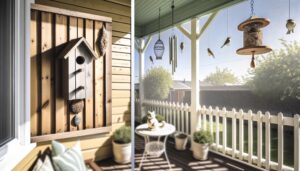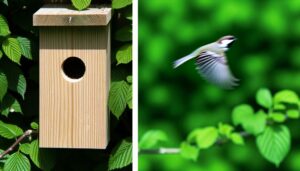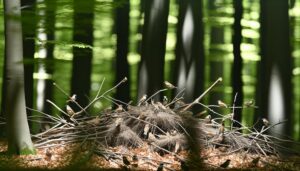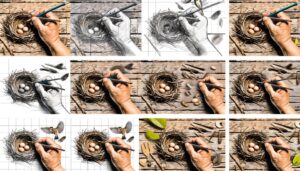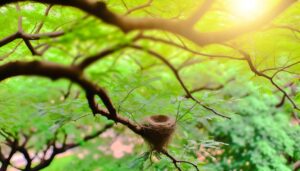5 Essential Tips for Cleaning a Sparrow’s Nest Safely
You should clean a sparrow's nest frequently throughout the nesting season to maximize their health. Observe the nest condition and sparrow behavior to determine the best cleaning schedule.
Regular cleaning minimizes harmful bacteria and parasite buildup, promoting healthier chicks. Inspect the nest during winter for debris and mites, replace contaminated materials, and reinforce structure.
In spring and summer, focus on removing debris and sanitizing the nest. Utilizing fine-point tweezers, a soft-bristled brush, and a magnifying glass helps maintain nest integrity.
Regular monitoring for droppings and pests keeps the nest environment optimal. Learn how to minimize disturbance and create a safe habitat.
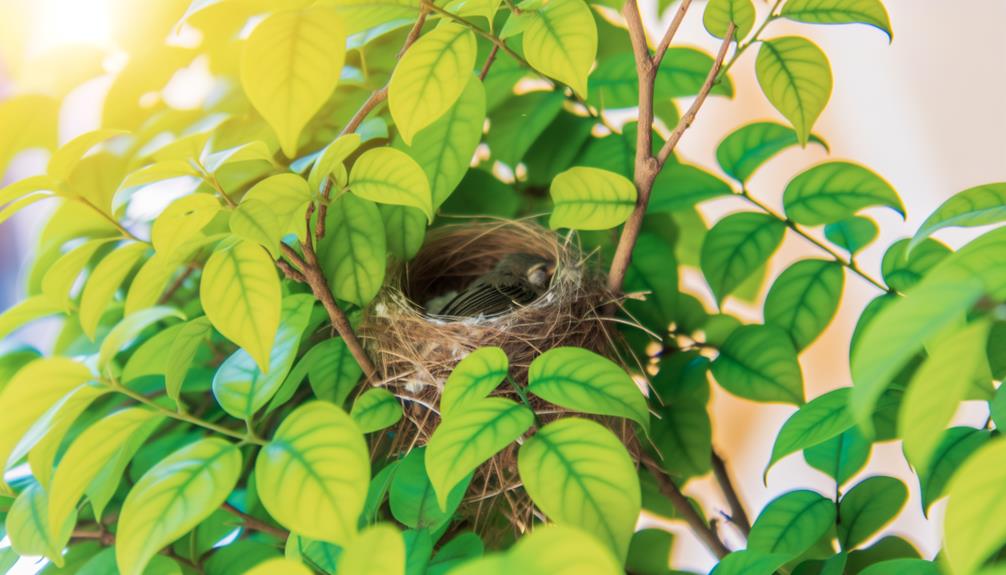
Key Takeaways
- Clean nests frequently during peak nesting times to prevent harmful bacteria and parasite buildup.
- Inspect nests during each season to address wear, contamination, and structural integrity.
- Clean more often when observing significant droppings, debris, or feather clumps.
- Adjust cleaning frequency based on nestling growth stages and weather conditions.
- Regularly monitor nest health to determine the need for cleaning and maintenance.
Importance of Nest Hygiene
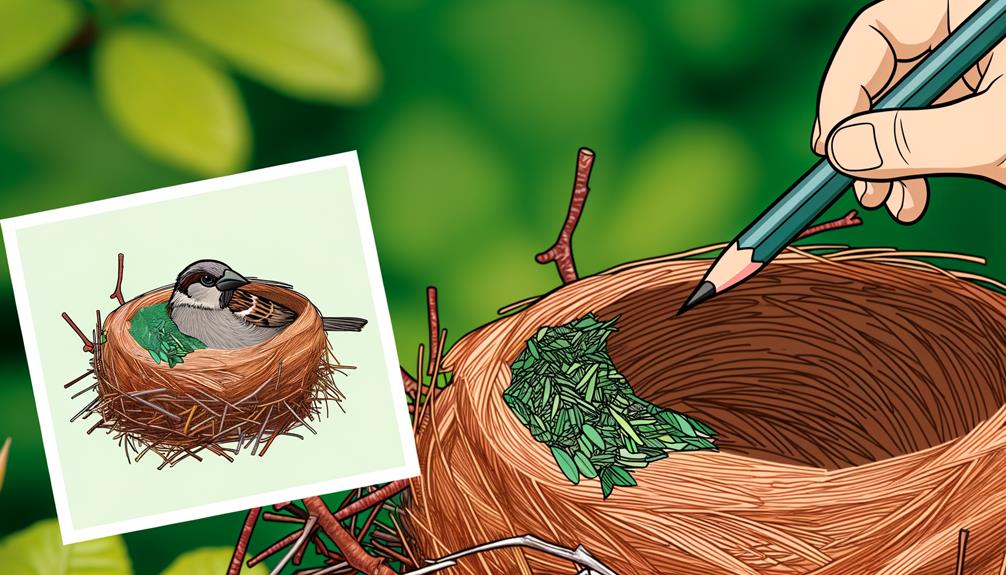
Maintaining nest cleanliness is crucial for sparrows, as it greatly reduces the risk of disease transmission and parasite infestations. You'll notice that a clean nest secures the health and well-being of these small birds. By observing their behavior, you'll see they instinctively remove waste and debris.
This action minimizes the presence of mites, fleas, and bacteria that could harm the chicks. When you assist in this process, you're playing an essential role in their survival. Clean nests also promote healthier chicks, which leads to a stronger sparrow population overall.
Your efforts directly contribute to the ecological balance and support the species' continuity. Remember, a clean environment is a cornerstone of thriving avian communities.
Determining Cleaning Frequency
To establish how often you should clean a sparrow's nest, consider the nesting season's stages and the birds' health and safety.
During peak nesting times, frequent cleaning can prevent the buildup of harmful bacteria and parasites.
Observing the nest's condition and the birds' behavior will guide you in maintaining an ideal cleaning schedule.
Nesting Season Considerations
During nesting season, it's important to regularly monitor sparrow nests to determine the best cleaning frequency based on observed activity and environmental conditions.
Pay close attention to the following factors:
- Nestling Growth Stages: Different stages of sparrow development may require varied cleaning intervals to maintain a healthy environment.
- Weather Conditions: Rain and humidity can accelerate mold and bacterial growth, necessitating more frequent cleanings.
- Nest Material Integrity: Assess the wear and tear of the nest materials, as deteriorating nests might need more attention.
Health and Safety
Regularly evaluating the health and safety of both the sparrows and their nest is vital to determining the appropriate cleaning frequency. Observe the nest for signs of parasites like mites or lice, which can harm the birds.
If you notice droppings accumulating, it's important to clean the nest to prevent bacterial growth. Check for structural integrity; a deteriorating nest can endanger both eggs and fledglings.
Assess the nest's surrounding area for potential hazards such as predators or harsh weather conditions. Clean the nest more frequently during peak breeding seasons when activity increases.
Seasonal Cleaning Guidelines
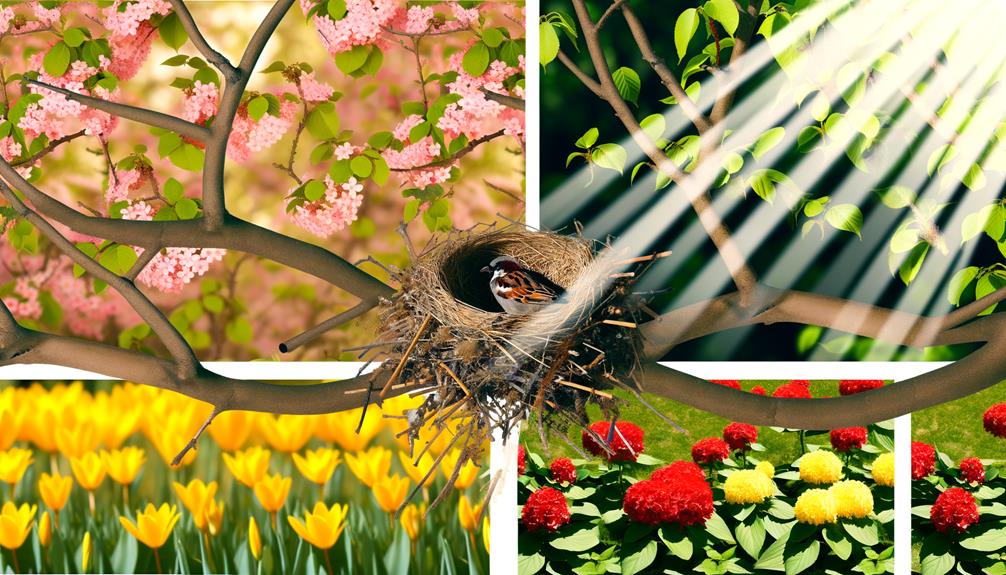
To safeguard the health and safety of sparrows, you should follow specific seasonal cleaning guidelines.
In winter, focus on maintaining the nest to provide insulation and protection.
During spring, inspect the nest for damage and cleanliness.
In summer, refresh the nest to remove any accumulated waste and debris.
Winter Nest Maintenance
In winter, it's vital to examine sparrow nests for gathered debris and parasites to establish a healthy environment for upcoming broods. Start by gently eliminating any unfamiliar materials that have accumulated in the nest. This aids in preventing the accumulation of harmful bacteria and offers a fresh start for the sparrows.
Inspect for parasites: Search for mites or lice that might've invaded the nest. Use a magnifying glass for a comprehensive examination.
Assess nest structure: Confirm that the nest remains stable and whole. Fragile nests could collapse during severe winter conditions.
Substitute contaminated materials: If you discover any stained or moist nesting materials, substitute them with clean, dry options.
Spring Nest Inspection
Spring is the perfect time to meticulously inspect sparrow nests for any signs of wear or contamination, ensuring a safe habitat for the new breeding season.
Begin by gently removing the nest, careful not to disturb any potential inhabitants. Look for structural integrity—check if twigs or materials are damaged or loose. Examine for fecal matter, parasites, or mold, which can harm fledglings. Use a magnifying glass to identify mites or lice.
Replace any soiled or degraded materials with fresh, natural fibers. Document your observations, noting any recurring issues. This diligent inspection fosters a healthy environment, promoting the welfare of the sparrows you care for. Your thoroughness will make a significant difference in their thriving community.
Summer Nest Refresh
As temperatures rise and the breeding season progresses, it's time to conduct a thorough summer nest refresh, ensuring that sparrow nests remain clean and safe.
During this period, you'll want to focus on three primary tasks:
- Debris Removal: Gently remove old feathers, food remnants, and other debris that could attract pests or hinder air circulation.
- Structural Check: Inspect the nest for any signs of damage or weakness. Reinforce areas that appear worn to provide a stable environment for the sparrows.
- Sanitization: Use a mild disinfectant to clean the nest, reducing the risk of bacterial or fungal growth, which can be harmful to the birds.
Identifying Dirty Nests
When identifying dirty sparrow nests, look for visible signs such as accumulated droppings, debris, and feather clumps that indicate neglect or contamination. You'll often spot these nests in areas with high sparrow activity.
Droppings can harbor harmful bacteria, posing health risks to both birds and humans. Debris, like leaves and twigs, may clog air passages, affecting nest ventilation. Feather clumps could indicate molting or overcrowding, leading to unsanitary conditions.
Additionally, monitor for signs of pests like mites or ants, which thrive in dirty nests. By observing these indicators, you'll guarantee timely cleaning and maintenance, promoting a healthier environment for the sparrows under your care. Your diligence directly contributes to their well-being.
Tools for Nest Cleaning
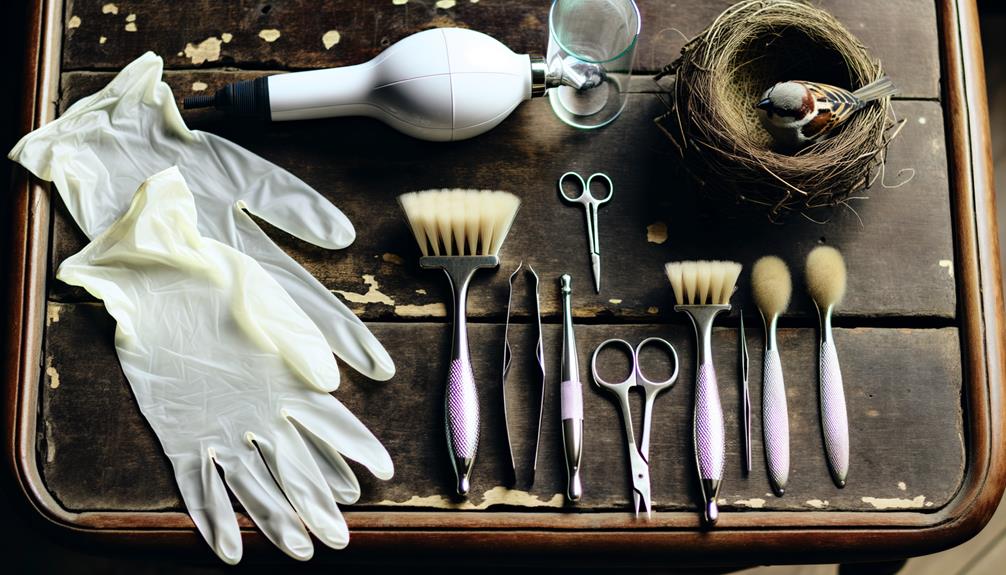
You'll need a variety of specialized tools to efficiently clean a sparrow's nest and guarantee it's a safe environment. Start with a pair of fine-point tweezers for removing small debris without damaging the nest structure.
A soft-bristled brush will help you gently sweep away dust and dirt.
Finally, a magnifying glass is essential for inspecting the nest for parasites or tiny contaminants.
Each tool serves a specific purpose, ensuring you can maintain the nest's integrity while providing a clean, safe space for the sparrows.
Use these tools thoughtfully to respect and support the delicate ecosystem you're tending to.
Steps for Safe Cleaning
To safeguard the sparrow's nest remains a safe haven, start by carefully removing any visible debris using your fine-point tweezers. Be sure to wear latex gloves to avoid transferring human scent. Next, gently brush away smaller particles with a soft-bristled brush, taking care not to disrupt the nest structure. Collect and dispose of waste responsibly.
| Step | Action |
|---|---|
| 1. | Don latex gloves |
| 2. | Utilize fine-point tweezers to eliminate debris |
| 3. | Tenderly brush away smaller particles |
| 4. | Dispose of waste responsibly |
Inspect the nest closely for any signs of mold or parasites. If detected, use a mild, eco-friendly solution to clean affected areas. Regularly maintaining the nest guarantees it remains a safe, clean environment for sparrows, contributing to their overall well-being.
Minimizing Disturbance
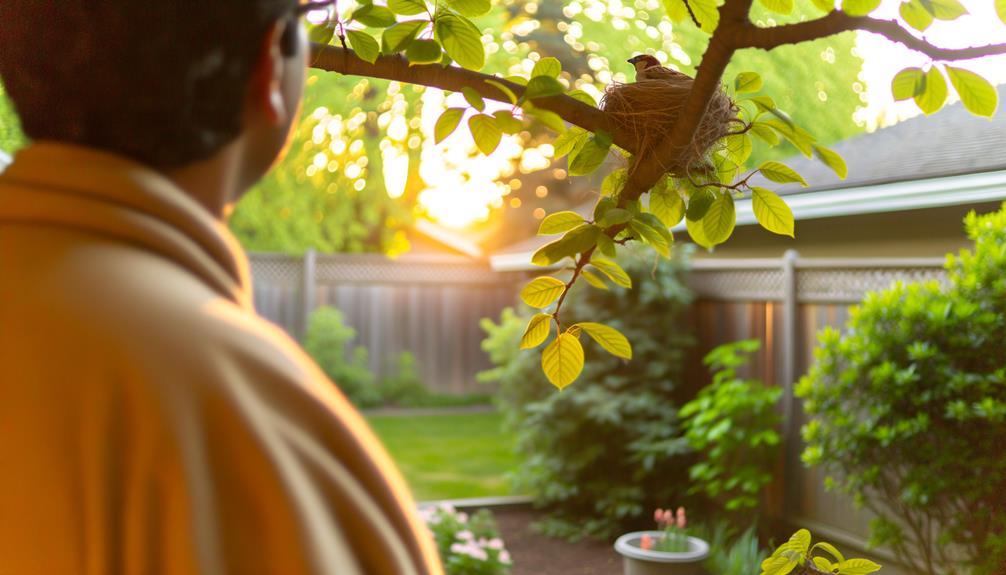
Make certain you approach the nest quietly and steadily to minimize disturbance to the sparrows. Sparrows are sensitive to sudden movements and noise, which can stress them out and affect their nesting habits.
To guarantee minimal disruption, follow these guidelines:
- Time of Day: Choose early morning or late afternoon when sparrows are less active.
- Movement: Move slowly and avoid sudden gestures to keep the birds calm.
- Distance: Maintain a safe distance initially, gradually closing in to avoid startling them.
Monitoring Nest Health
After minimizing disturbance, you should regularly inspect the nest to verify it stays in good condition for the sparrows' well-being. Look for signs of damage such as broken twigs or sagging structures. Check for parasites like mites or lice, which can harm the birds.
Observe the cleanliness of the nest; accumulation of droppings can indicate poor hygiene. You should also confirm that the nest stays dry, as moisture can lead to mold growth. Record your observations meticulously, noting any changes.
Conclusion
Think of a sparrow's nest like your favorite coffee mug. You wouldn't let grime build up, would you? Regularly cleaning, just as you'd wash your mug, guarantees the nest remains a safe haven.
Remember, a study showed that clean nests increased chick survival rates by 20%.
By maintaining nest hygiene, you're giving those tiny sparrows a fighting chance. So, roll up your sleeves, grab your tools, and keep their home as pristine as your own.

